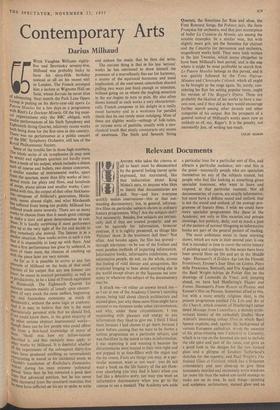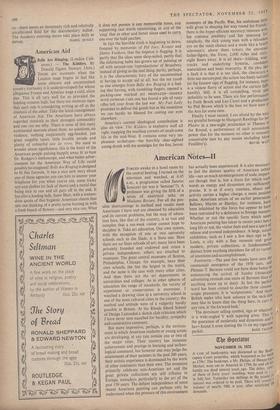Relevant Documents
ANYONE who takes the cinema at all to heart must be disconcerted by the general feeling (never quite expressed, but murmured, like that indiscretion about King Midas's ears, to anyone who likes to listen) that documentaries are dull. Not—and here everyone quickly makes reservations—this or that out- standing documentary; but, in general, informa- tive films on particular subjects shown in ordinary feature programmes. Why? Are the subjects dull? Not necessarily. Besides, few subjects are intrinsi- cally dull if they are treated properly; and we can be squirrels for information, however abstruse, if it is rightly presented, as things like 'Pelicans' show. Is the treatment dull then? Not often. And besides again, the film has proved— through television—to be one of the liveliest and most painless methods of imparting information. Informative books, informative exhibitions, even informative people, do not, on the whole, arouse this feeling of mild dismay and antagonism, this irrational longing to hear about anything else in the world except elvers or the Japanese tea cere- mony or whatever the subject of the documentary may be.
It struck me—or rather an answer struck me— as I sat at one of the Academy Cinema's morning shows, being told about church architecture and stained glass, just why these same films might have seemed to me tiresome under other circumstances, and why, under these circumstances, I was responding with pleasure and energy to any information they liked to give me. I think I liked them because I had chosen to go there, because I knew before coming that we were to be shown a serious programme on a particular subject, and was therefore in the mood to take in information; I was expecting it and wanting it because the documentaries were treated in their own right and not popped in as time-fillers with the organ and the ice cream. Facts are things you may, at a par- ticular moment, want or not want: you do not want a book on the life history of the ant (how- ever absorbing you may find it later) when you feel like a detective story, nor may you want an informative documentary when you go to the cinema to see a musical. The Academy sets aside a particular time for a particular sort of film, and attracts a particular audience; not—and this is the point—necessarily people who are specialists themselves on any of the subjects treated, but people who feel like looking at something given specialist treatment, who want to learn and respond, at that particular moment. Not all documentaries, of course, are strictly informative; but most have a definite mood and outlook that is not the mood and outlook of the average pro- gramme of feature films. I wish we could have more specialist programmes like these at the Academy, not only in film societies and private showings, but publicly, daily, and as much a part of the pattern of normal filmgoing as informative books are part of the general pattern of reading. The most ambitious series in these morning shows, which are now in their second year, is one that is intended in time to cover the entire history of painting and sculpture. In this series there have been several films on life and art in the Middle Ages : Haessaert's A Golden Age (on the Flemish Primitives); Emmer's four films on Giotto, Piero della Francesca, Botticelli, and Fra Angelico, and the Basil Wright-Adrian de Poitier film on the drawings of Leonardo da Vinci; and, jumping ahead, we have had Hoellering's Shapes and Forms, Haessaert's From Renoir to Picasso, and Emmer's film on Picasso. Somewhat allied to this, but with a more strictly religious slant, is the present programme entitled The Life and Art of the Church, which consists of Hoellering's rather dated Message from Canterbury, a sketchy archi- tectural history of the cathedral; Dudley Shaw Ashton's interesting colour films in which Basil Spence explains, and, against the background of various European cathedrals tr•ces the ancestry of his prize-winning new Cathedral at Coventry, which is to rise on the bombed site and to include the old spire and part of the ruins, and gives us a good look at the designs for the new stained glass and a glimpse of Graham Sutherland's sketches for the tapestry; and Basil Wright's The Stained Glass at Fairford, which has a Betjeman commentary and uses close-up to give these immensely detailed and immensely worn windows far more life than the naked eye could manage to make out on its own. In such things—painting and sculpture, architecture, stained glass and so on—there seems an immensely rich and relatively uncultivated field for the documentary maker. The Academy morning shows take place daily at











































































 Previous page
Previous page